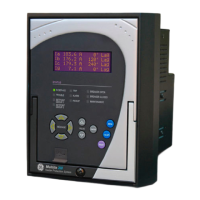
Do you have a question about the GE 350-A9 and is the answer not in the manual?
Introduction to the 350 Feeder Protection System, its benefits, and features.
Details the system's CPU, analog input, frequency measurement, and processing.
Information on how to specify a 350 relay through order codes and options.
Describes the mechanical aspects of installing the 350 system, including dimensions.
Provides detailed drawings of the 350 unit dimensions for drawout and non-drawout configurations.
Explains the product identification label details, including model, serial number, and date.
Details standard panel mounting and cutout dimensions, and adapter plate mounting.
Describes the front panel interface, including LEDs, control keys, and display.
Explains the relay front panel features: LCD, LEDs, control keys, and USB port.
Details the 80-character LCD display and its visibility under various lighting conditions.
Explains how to navigate the 350's menu structure using the keypad.
Details the EnerVista 3 Series Setup software for programming, monitoring, and upgrading the relay.
Provides instructions for establishing communication via serial, USB, or Ethernet.
Explains how to access measured values, digital inputs/outputs, and fault analysis in Actual Values mode.
Details the status information for Clock, Contact Inputs, Output Relays, Logic Elements, Virtual Inputs, and Remote I/O.
Covers the measured values for currents, voltages, frequency, power, energy, and demand.
Explains the Event Recorder, Transient Recorder, and Fault Report functionalities for logging events and faults.
Describes how target messages are automatically displayed for active conditions like pickups, trips, and alarms.
Introduces the Quick Setup utility for fast programming of power system parameters and overcurrent elements.
Lists setpoints that can be programmed via the Quick Setup menu, covering CT, VT, and overcurrent functions.
Organizes programmable setpoints into pages and subpages for protection, controls, and monitoring.
Describes methods for entering setpoints: front panel keypad, USB, or RS485/Ethernet.
Provides general descriptions for common setpoint types like FUNCTION, OUTPUT RELAY, PICKUP, BLOCK, DELAY, and DIRECTION.
Explains how logic diagrams illustrate setpoints, inputs, and internal logic for feature operation.
Lists common abbreviations used in setpoint pages for clarity.
Covers Clock settings, Password security, Communications, Redundancy, Modbus, IEC, DNP, GOOSE, OPC-UA, Event/Transient Recorders, Fault Report, LEDs, and Installation.
Configuration for Current sensing, Voltage sensing, Power system, Breaker status, User curves, and FlexCurves.
Details overcurrent, directional, undervoltage, overvoltage, frequency, thermal overload, and power fault protection elements.
Covers setpoint group switching, virtual/remote inputs, logic elements, breaker control, CLP, breaker failure, CT failure, autorecloser, synchrocheck, harmonic inhibit, lockout, VT fuse fail, and arc flash.
Details configuration for contact inputs, output relays, virtual inputs, and remote inputs.
Covers monitoring of demand (current, real, reactive, apparent power) and thermal capacity.
Displays relay name, order code, firmware revision, and build date.
Covers breaker maintenance aspects: trip coil, close coil, trip counter, breaker health, and counter resets.
Monitors the status of breaker trip/close coils and circuits, displaying "Unhealthy" on failure.
Monitors ambient temperature around the relay chassis to detect conditions that may degrade product life.
Describes test modes for front panel LEDs and output relays, including force LED and force output relay functions.
Details warranty information for products shipped as of October 2013 and before.
Outlines the process for returning the device to the factory for repair, including RMA and shipping instructions.
Lists manual revision history with corresponding release dates for different P/N.